Moving and shaking DIY biotech at BioCurious
Published 16 October 2018 by Cherise Fong
In California, community biology laboratory BioCurious is a catalyst for innovation in biotechnology, where biohacking is accessible to anyone, from independent researchers and entrepreneurs to budding citizen scientists. Makery stopped in for a visit.
Santa Clara, special report (words and photos)
From the outside, BioCurious could almost be mistaken for another tech startup niched inside an unassuming concrete office building. But once past the unmanned reception desk, a slightly different image comes into focus: a cork community board hosts a help-wanted notice for a lab assistant, across from an ad for The Odin by Josiah Zayner, above highlights of the upcoming American Society of Human Genetics conference, next to a pizza delivery menu. On one table, a mysterious aquarium is attached to a GoPro-like device labeled “CuttleCam”. On the wall above the coffee mugs, a small poster features a quote attributed to Albert Einstein: “I have no talent, I am only passionately curious.”

BioCurious has come a long way in the past seven years. First conceived as a DIY biolab inside a garage, it was reborn through a crowdfunding campaign as a community laboratory renting commercial space in Sunnyvale, before maturing into the pioneering biohackerspace it has since become, while settling into its current location in Santa Clara, in the South Bay of San Francisco.
Officially founded by a handful of biology-oriented entrepreneurs in late 2010, the not-for-profit BioCurious seems very much at home in the biotech heart of Silicon Valley. It counts about a hundred active members, with a broader community of several hundred. In the daytime, the laboratory provides a dedicated space for members to work on their own projects, while almost every evening the space hosts bio-themed meetups and ongoing community projects. On weekends, visitors often include families and teenagers participating in science fairs or other student activities.
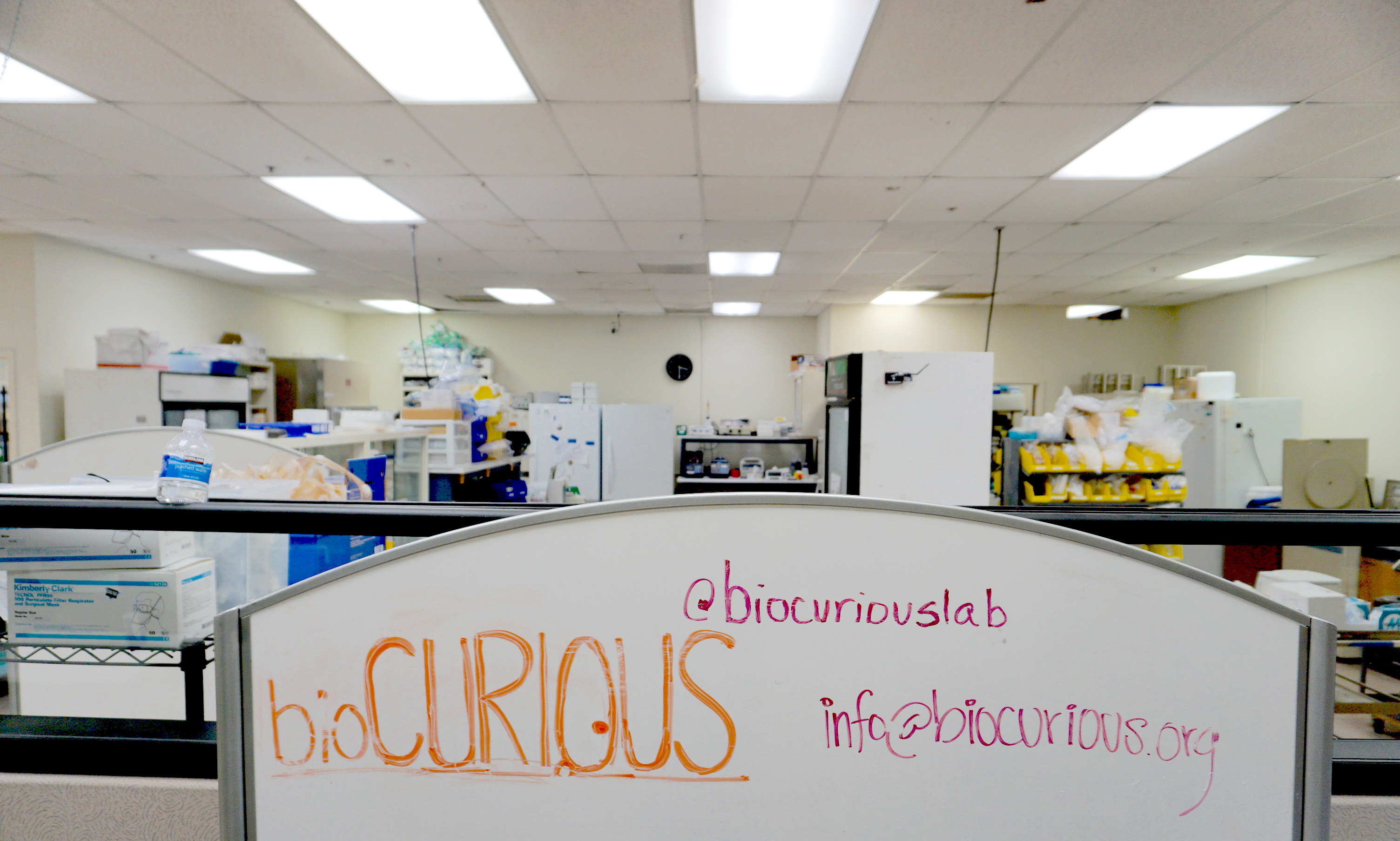
From startups to cuttlefish
Innokenti Toulokhonov, a current board member of BioCurious, was one of the lab’s early members when he joined in 2012. Like many individuals, he was looking for affordable and fully equipped biochemistry lab space to work on personal side projects. It was here that he launched his startup, Amid Biosciences, which provides services in protein engineering and gene cloning for research in life science. Another benefit of BioCurious, he points out, is that it never takes any intellectual property or ownership of your future or current projects.
One of BioCurious’s first original community projects is the BioPrinter, an inkjet printer hacked into a 3D printer of… human organs. While the DIY machine hasn’t quite yet achieved its ultimate purpose, its process of transformation and operation, printing plant cells such as bamboo, is already being used as a collaborative educational project in which anyone can participate—including people beyond the Bay Area, across the U.S. to Florida, and even teenagers working on the software in Brazil.
As for the mystery tank by the entrance, it houses a male dwarf cuttlefish (Sepia bandensis), who is the subject of another community project to sequence his genome and edit his RNA. (Wanted: female dwarf cuttlefish.) A current deviation, which also involves high school students, biologists and software engineers, is to create “immortal” cell lines from the original cuttlefish cells.
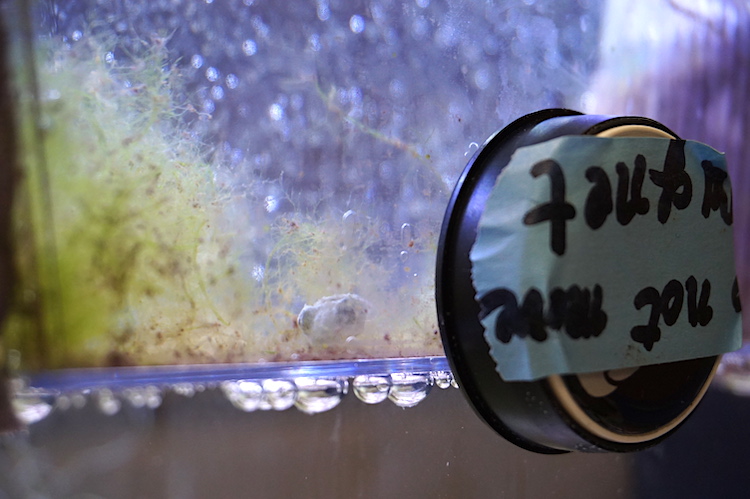
Open Insulin: coming soon to a bioreactor near you
If the award-winning Real Vegan Cheese project may be the most famous collaboration between BioCurious and Counter Culture Labs (CCL) in Oakland (which Makery also visited), perhaps the most fruitful is Open Insulin (first covered here). While the core team—protein biochemist Yann Huon de Kermadec, an anthropologist and a handful of other active members—base their work at CCL in the East Bay, Anthony Di Franco, Type 1 diabetic and instigator of the project, is exceptionally at BioCurious in person today to meet me. And he brings good news.
“Basically, we have a long-acting insulin equivalent working at lab scale,” he says. In other words, they have succeeded in producing generic insulin—the original goal of the Open Insulin Project. “Now we have a strain that makes proinsulin and a strain that makes the enzyme. We take the products of those two, purify them, mix them together to produce raw insulin, then purify insulin out from that. That’s what we’re doing now.”
They are also doing additional tests to double-confirm the results, while talking to lawyers about how they can safely and legally scale up and distribute the technology.
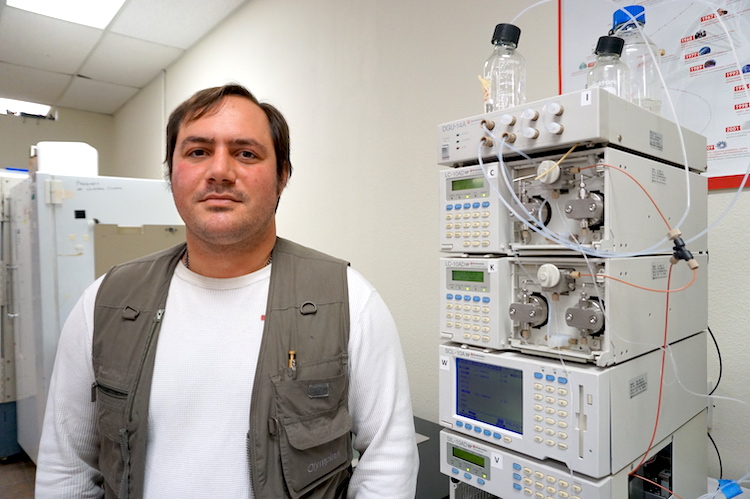
“We’re looking into building a whole platform that can be used for the small-scale manufacturing of insulin, on a scale that would make sense in a pharmacy or hospital setting or, for example, a clinic in Senegal, to serve multiple patients,” Anthony continues. “We want to build a slightly larger than lab-scale bioreactor, somewhere between 10-100 liters. Then if we get decent yields from that, we should be able to make enough insulin for thousands of people for a month, in a batch that runs for a couple of days or a week. Roughly speaking, a pretty small bioreactor can serve a lot of people, but we still need to look into how to make it safe and legal for human consumption.”
The long-term goal of the Open Insulin Project is to make the production of insulin open source and universally accessible. “From a technical aspect, the other part of the bioreactor is a purification system, which would require quality control tests on the other end to constantly monitor the product. We need to design those systems and create an open source production platform to make it well within reach of whoever needs it.”
At the individual home-use level, Anthony compares the complete system to the evolution of the personal home computer from the early 1970s, when only geek hobbyists knew how to build one, till now, when everyone has one. “Give it a few more decades,” he says. “This could get to the point where you make your own drugs more often than you buy them, if you need them at all. Simultaneously, things like gene therapies will be maturing, and we’ll be curing diseases more often than treating them. Hopefully the technology for that will be coming down in price and scale as well.”
BioCurious lab zone
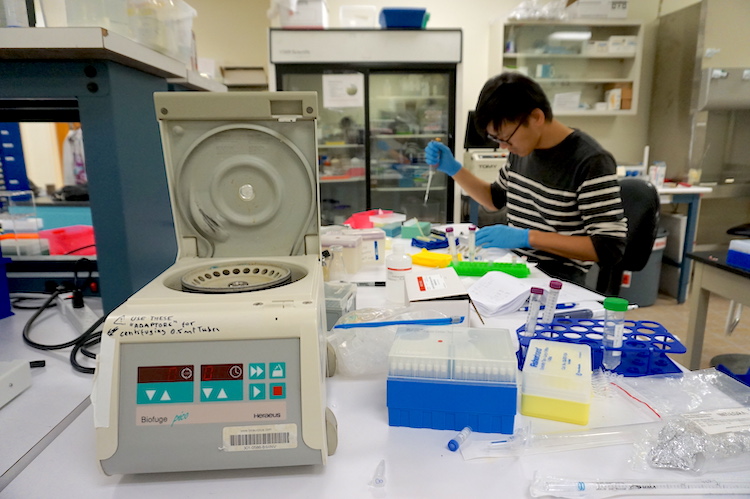
Meanwhile in the lab zone, Kurt Cheng is busy preparing samples for commercial DNA sequencing. Since becoming a member of BioCurious in 2016, he often uses the laboratory space to sequence DNA or even a whole genome for his clients. At the lab, he has also met new collaborators, many of whom are biotech researchers interested in leveraging this technique for things such as cancer detection or understanding a microbiome or the DNA of a specific species.
In a guided tour of the surrounding lab space, he shows me a centrifuge, a multifuge, an autoclave, a thermocycler, a shaking incubator, a rotating oven, a refrigerator used to store DNA at -20c, a freezer used to store RNA at -80c, a microscope that can see fluorescent genetic engineering, an HPLC to analyze chemical components… Most of the machines are vintage but functional, and all of the equipment has been donated.
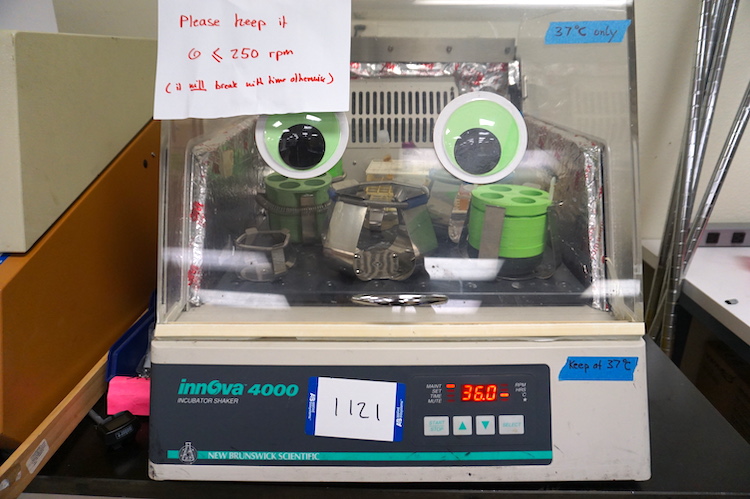
Electrophysiological fun with frog eggs
In a smaller room, another member has invested in his own specialized equipment to install a customized workspace for a personal research project in electrophysiology. Two years ago, Edward Beck moved up to the San Francisco Bay Area from San Diego, where he was unable to find work in his field at the PhD level, purposely to join BioCurious, which offered affordable lab space in a supportive environment, so that he could pursue his own research.
According to Edward, few people are well versed in the “meticulous technique” of electrophysiology. “It’s an analytical method used by people who study a class of proteins called ion channels,” he explains with academic precision. “The channels form a little hole, and what goes through them are ions, or charged atoms. There are several main types of ion channels, but the ones I’m studying are opened and closed by the voltage across the membrane. My particular application will be for nerve cells—electrical cells that have electrical conductive properties, because these nerve cells are long and skinny, and their membranes are loaded with these ion channels. All these ion channels are acting together in a symphony, opening and closing in a highly coordinated manner. That’s how you get a signal of pain from your toe to your brain.”
At BioCurious, Edward wants to explore a novel approach to be able to control this opening and closing of ion channels in nerve cells. While one up-and-coming approach over the past ten years is optogenetics, which uses light traveling through invasive fibre-optics, Edward proposes to use external magnetic fields to change the way ion channels open and close.
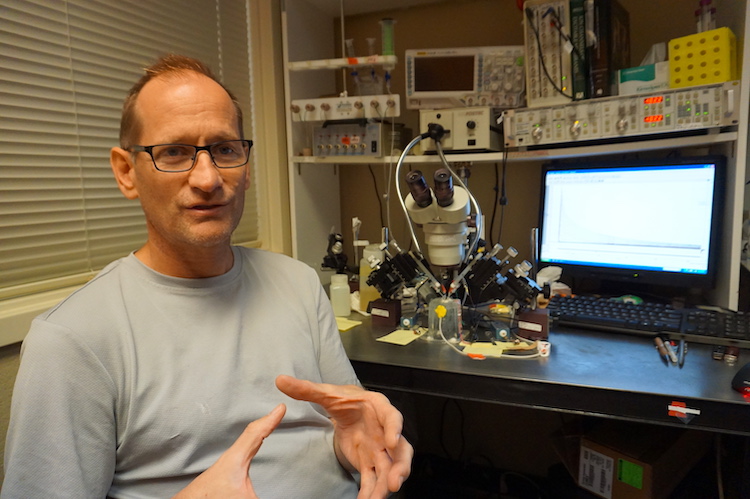
“I propose to bind a magnetic nano bead to a protein at a specific amino acid,” he explains, “in my case a cystine, so that it is bound to the ion channel. Then when the magnetic field is brought close, the magnetic particle will sense the magnetic field and move in whatever direction it dictates. And when the magnetic bead moves, so will the part of the protein that it’s attached to. I’m hypothesizing that that small part of the protein will cause it to open or close or somehow disrupt the normal behavior of the nerve cell.”
The electrophysiologist demonstrates the mechanics of his customized set-up, in which two glass electrodes poke straight down into the bottom of a dish, very delicately penetrating the membrane of a nerve cell inside a frog egg. The electrodes are connected to amplifiers, and a digital-analogue converter connects the signal to a computer, where Edward can program a specific set of voltage changes during the course of the experiment.
He is currently in the molecular biology phase of his research. “These are what I consider to be control sweeps,” he says, “without any magnetic beads, no mutagenesis of amino acids, no cystine. I just want to see what the ion channel looks like before I do all that. This is considered the control output of a protein found in a frog egg membrane. Then I would also inject the ovocytes into a different batch of ovocytes, with the RNA I got from changing one of those amino acids to a cystine. So when I express that protein in the frog egg, I can start to see if that introduced cystine will change the ‘wild type’ output of the ion channels. If there’s a big difference, then I did something right.”
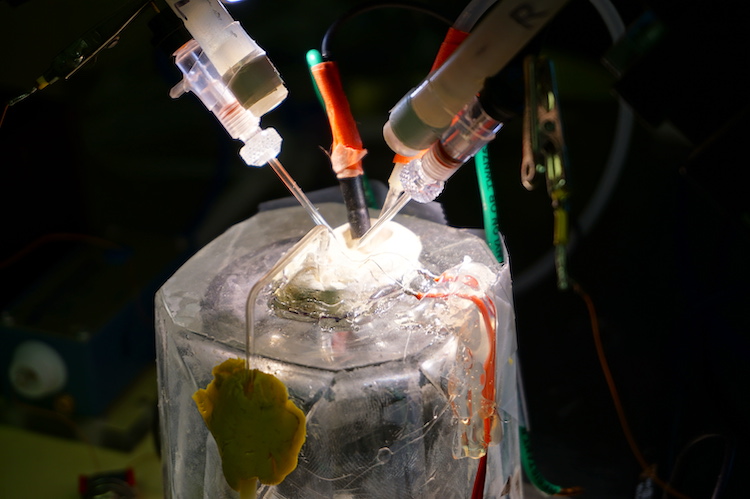
Edward plans to give his research project at least another three years. If he gets convincing enough data to show a proof of concept, he can use it to apply for a federal grant to take his research further. Another advantage of BioCurious is that it has the credentials to host research grants from the government. After that, who knows where the research can lead?
“I would like to see this technique applied in research labs trying to understand human behavior, the way we think,” says Edward. “How can we figure out where the dream centers are in your brain? Can we reproduce dreams by tickling a small part of your brain? Imagine enhancing people’s memory or pulling out memories… or being able to tweezer out the circuits that define the feelings of love—or hatred, or bias for people you like or don’t like. Is there a circuit for this? These ‘intangible things that humans think’ are all part of a neural network. This technique would help us figure out how those networks work.”
Magnetic nerve cell manipulation, DIY insulin production, 3D-printed organs, immortal cuttlefish cell lines… Which is most likely be the next big biotech breakthrough to come out of a community biolab? Just curious.
More info on BioCurious
